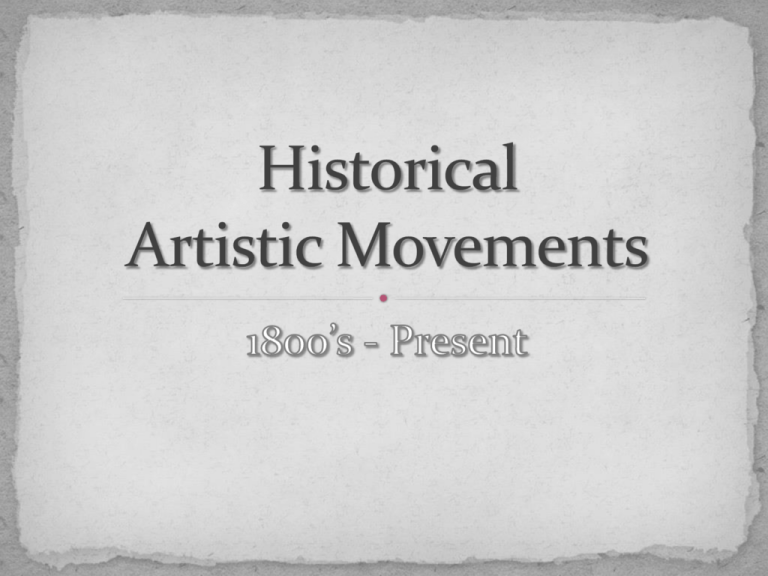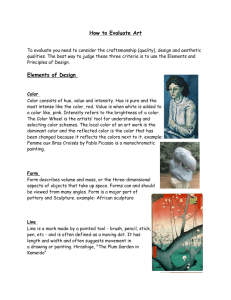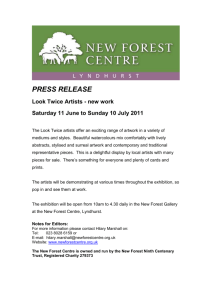Historical Artistic Movements - Hatboro
advertisement

Identify some of the most popular Western art movements of the past several centuries Chose an inspirational art movement upon which to base a dream room design Use design features in the dream room that reflect characteristics of chosen art movement Definition- A group of artists who agree on general principles Historians and art critics have categorized artwork into different “movements” based on the style and time period it was created in Throughout our history, artists have come together and created work that reflects the time period they were living in Each new art movement was usually born out of a revolt of previous movements and ideas. Artists were always pushing the boundaries of what was considered acceptable. They were always rebellious! Analogy: Art Movements are like styles and trends in fashion Every few years, people rebel against the norm, and new trends emerge that remain grounded in a certain time period However, multiple styles can exist at once (i.e. punk, preppy, hipster, classic, etc.) Started in France and Britain It’s an emotional style that is individualistic, beautiful, exotic, and emotionally wrought Artists: Francisco Goya, William Blake, JMW Turner, Eugene Delacroix Started in America in the Hudson River Valley Landscape painters were influenced by Romanticism Artists: Thomas Cole, Charles Baker, Albert Bierstadt Began in France as a revolt against the exotic subject matter and exaggerated emotionalism and drama of the Romantic movement Artists sought to portray real and typical contemporary people and situations with truth and accuracy Artists: Gustave Courbet, Jean-Francois Millet, Edouard Manet Began in Paris Paintings of outdoors scenes had loose brush strokes and bright colors Artists: Claude Monet, Camille Pissarro, PierreAuguste Renoir, Edgar Degas, John Singer Sargent French artists extended Impressionism while rejecting its limitations Used vivid colors and brush strokes, but distorted form for expressive effect, and used unnatural or arbitrary colors Artists: Georges Seurat, Paul Cezanne, Vincent Van Gogh, Henri de ToulouseLautrec, Paul Gauguin Began in Germany at the turn of the 20th century The artist evoked emotion through distortion, exaggeration, primitivism, fantasy, and nonnaturalistic and exuberant colors Artists: Henri Matisse, Edvard Munch, Ernst Ludwig Kirchner, Amedeo Modigliani, Max Beckmann Took Europe by storm at the turn of the century As a rejection of all previous traditions, art is broken down into its most simple elements (line, shape, space, etc.) Artists: Piet Mondrian, Mark Rothko Began in Paris by Picasso and Braque Cubists broke from centuries of tradition in their paintings by rejecting the single viewpoint Artists: Georges Braque, Pablo Picasso, Juan Gris, Paul Klee, Marc Chagall, Marcel Duchamp Began in Italy Glorified themes in painting and sculpture associated with the future, including speed, technology, youth and violence, and objects such as the car, the airplane, and the industrial city Artists: Giacomo Balla, Umberto Boccioni Began in Paris, and emerged from Dadaism Dedicated to expressing the imagination as revealed in dreams, artists painted unnerving, illogical scenes and created strange creatures from everyday objects Artists: Salvador Dali, Rene Magritte, Max Earnst, MC Escher, Frida Kahlo Also known as the “New Negro Movement,” began in Harlem, NY An African-American movement depicting daily life in Harlem Artists: Jacob Lawrence, Romare Bearden Started in NY, post WWII Aimed at subjective emotional expression with a particular emphasis on the creative spontaneous act (like action painting) Artists: Wassily Kandinsky, Jackson Pollock, Willem De Kooning, Francis Bacon Started Britain in the 1950s, and the U.S. in the 1960s Mocks popular culture by using everyday items, like Campbell’s Soup Cans and advertisements in artwork Artists: Roy Lichtenstein, Andy Warhol, Claus Oldenburg Began in different places when certain artists started experimenting with illusions Called “Optical” Art, this genre makes use of optical illusions in artwork Artists: Bridget Riley, Victor Vasarely Born out of cultural revolutions in the 1960s worldwide It’s a rejection of the norm; a more eclectic and populist approach to creativity. ANYTHING can be considered ‘art’ Artists: Keith Haring, Fernando Botero, Damien Hirst, Kara Walker, Jasper Johns These were just the most well- known Western Art Movements from 1800-Present Other cultures have their own history of art creation (Folk Art, African Art, Japanese Art, Aboriginal Art, etc.) You may choose to research one non-Western Art movement, if you feel strongly about doing so





